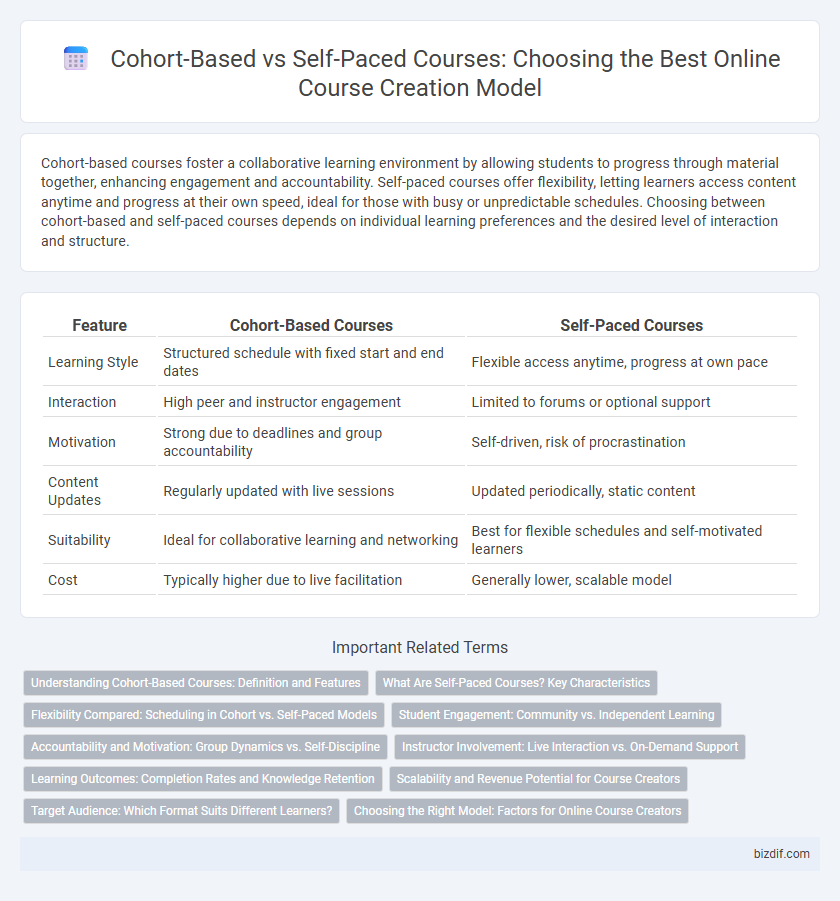Cohort-based courses foster a collaborative learning environment by allowing students to progress through material together, enhancing engagement and accountability. Self-paced courses offer flexibility, letting learners access content anytime and progress at their own speed, ideal for those with busy or unpredictable schedules. Choosing between cohort-based and self-paced courses depends on individual learning preferences and the desired level of interaction and structure.
Table of Comparison
| Feature | Cohort-Based Courses | Self-Paced Courses |
|---|---|---|
| Learning Style | Structured schedule with fixed start and end dates | Flexible access anytime, progress at own pace |
| Interaction | High peer and instructor engagement | Limited to forums or optional support |
| Motivation | Strong due to deadlines and group accountability | Self-driven, risk of procrastination |
| Content Updates | Regularly updated with live sessions | Updated periodically, static content |
| Suitability | Ideal for collaborative learning and networking | Best for flexible schedules and self-motivated learners |
| Cost | Typically higher due to live facilitation | Generally lower, scalable model |
Understanding Cohort-Based Courses: Definition and Features
Cohort-based courses are structured learning experiences where groups of students progress through the curriculum together, fostering collaboration and real-time interaction. Key features include scheduled live sessions, peer discussions, and guided pacing, which enhance motivation and accountability. This format contrasts with self-paced courses by emphasizing community engagement and synchronous learning dynamics.
What Are Self-Paced Courses? Key Characteristics
Self-paced courses allow learners to progress through the material at their own speed, offering flexibility to accommodate different schedules and learning styles. These courses typically feature pre-recorded videos, downloadable resources, and quizzes that students can access anytime, providing convenience and autonomy. Key characteristics include asynchronous learning, customizable pacing, and the ability to revisit content multiple times for better retention.
Flexibility Compared: Scheduling in Cohort vs. Self-Paced Models
Cohort-based courses offer structured scheduling with fixed start and end dates, fostering real-time interaction but limiting individual flexibility. Self-paced courses provide complete scheduling freedom, allowing learners to progress at their own speed and adjust timelines as needed. This flexibility in self-paced models accommodates diverse learning preferences and busy schedules more effectively than the rigid timelines of cohort-based courses.
Student Engagement: Community vs. Independent Learning
Cohort-based courses foster student engagement through structured interaction, peer collaboration, and real-time feedback within a community setting, enhancing motivation and accountability. In contrast, self-paced courses prioritize independent learning, allowing students to progress at their own speed but often resulting in lower social interaction and potential isolation. Research shows that cohort-based models improve course completion rates by up to 20% due to increased community support and shared learning experiences.
Accountability and Motivation: Group Dynamics vs. Self-Discipline
Cohort-based courses enhance accountability and motivation through structured group dynamics, fostering peer support and real-time feedback that drive consistent progress. Self-paced courses rely heavily on individual self-discipline, requiring learners to set personal goals and maintain focus without external pressure. Group interactions in cohort-based models create a compelling environment for sustained engagement compared to the often solitary nature of self-paced learning.
Instructor Involvement: Live Interaction vs. On-Demand Support
Cohort-based courses require high instructor involvement through live interaction, fostering real-time engagement and personalized feedback. Self-paced courses rely on on-demand support, allowing learners to access materials and assistance asynchronously, which reduces direct instructor presence. This distinction impacts learner motivation and flexibility, with cohort models enhancing community and accountability while self-paced models offer convenience and scalability.
Learning Outcomes: Completion Rates and Knowledge Retention
Cohort-based courses demonstrate higher completion rates, often exceeding 70%, due to structured schedules and peer accountability, which boost learner motivation. Self-paced courses frequently experience lower completion rates, averaging around 30-40%, as flexible timelines can lead to procrastination and reduced engagement. Knowledge retention tends to be stronger in cohort-based models because interactive discussions and collaborative projects enhance comprehension and long-term memory.
Scalability and Revenue Potential for Course Creators
Cohort-based courses foster higher engagement through scheduled interactions, enabling creators to charge premium prices and build strong community-driven brands, which enhances revenue potential. Self-paced courses offer greater scalability by accommodating unlimited learners simultaneously without additional instructor time, maximizing passive income opportunities. Balancing cohort-based exclusivity and self-paced accessibility allows course creators to optimize both scalable growth and diversified revenue streams.
Target Audience: Which Format Suits Different Learners?
Cohort-based courses suit learners who thrive in structured environments with scheduled deadlines and interactive peer engagement, often favoring professionals seeking accountability and networking opportunities. Self-paced courses appeal to independent learners prioritizing flexibility, such as busy parents or working individuals balancing multiple commitments. Understanding the target audience's learning preferences and time constraints is essential for selecting the optimal course format.
Choosing the Right Model: Factors for Online Course Creators
Choosing the right course model depends on target audience engagement and learning goals; cohort-based courses foster interaction and accountability through scheduled sessions, while self-paced courses offer flexibility and scalability for independent learners. Course creators should evaluate factors such as learner motivation, content complexity, and desired community involvement to optimize outcomes. Effective selection enhances course completion rates and learner satisfaction in the online education landscape.
Cohort-based courses vs Self-paced courses Infographic

 bizdif.com
bizdif.com